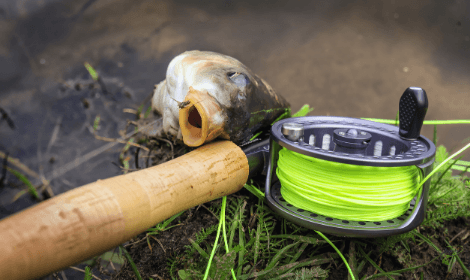
There are endless approaches to catching carp. This differentiates the sport from many other types of angling which makes it no surprise that carp fishing is one of the most sought after sport fish in the UK and across Europe.
The diverse and complex approaches to catching these fish takes a lot of skill that differentiates itself from the stereotypical fishing of throwing a float out with some bait and leaving it.
Believe it or not, fly-fishing for carp adds a completely new angle to carp fishing and a whole new set of skills that don’t just lend them self to fishing for trout and grayling on your local river.
In this post we’re going to be providing a full in-depth guide on how to fly fish for carp including the tackle you’ll need, the fishing approach, the flies you’ll need, how to fight a carp on the fly and even the best weather for fly-fishing for carp.
Tackle
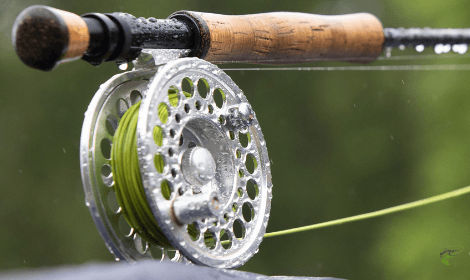
Rod
The first step to catching carp on the fly is naturally going to be the tackle you’ll need. Unfortunately your prettied rigs, match feeder rod and bait casting reel is just not going to cut it for this style of carp fishing.
Selecting a fly rod is far different from selecting a normal fishing rod and the process can be slightly more complicated. As well as lengths and actions the main thing you’ll need to be worried about is the “weight” of the rod.
No, this doesn’t mean the actual physical weight of the rod but the category of #2 up to around #12. These weights which are represented by a # then the number in most cases refer to the lightness of the rod and the situations it will be best used in.
Rods of about #2 to #4 are most commonly used for streams and brooks where casting far is not required and the fish you are targeting are relatively small of under around 1lb.
I’m sure you’ll know that this won’t cut it for carp fishing. It’s very rare you’ll be catching many fish below 1lb and it shouldn’t be too uncommon to be hooking into fish reaching the 10lb mark.
#5 and #6 rods are most commonly used for smallish rivers, small still water venues and are good for casting light flies decent distances with some finesse as not to spook nearby fish.
A #6 rod would be not too bad for casting carp flies at cruising fish but the fight might just be a bit unmanageable as these rods are still usually pretty light with a lot of flex. By all means if you hook a decent carp on a 6 weight rod you’re going to be in for some fight.
#7 or #8 rods are probably the best suited for carp angling with flies. They provide a decent balance between finesse and casting small flies distances with enough power in the blank to fight carp of all sizes.
Reel
Now, you’re obviously going to need a reel. Fly fishing reels also come in weights that must match your rod for perfect balance which allows you to cast out your new line which is also rated.
If you’re opting for a #7 rod then the reel and the line must match. Once you know which rod you are going for then picking a reel and line should be pretty straight forward.
When fly-fishing for carp you’re most commonly going to be fishing off the surface so a floating line is what you should be opting for. We’ll get more into the approach in the section below.
Fishing Approach
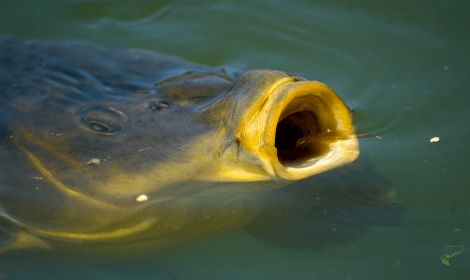
Surface Fishing
One fishing approach for fly-fishing for carp is actually pretty similar to that of standard surface fishing for carp but with the added skill of a fly cast.
That’s not to say that fishing with particular wet flies, flies that sink, won’t catch you carp but the most common approach is definitely to fish for them on the surface.
The surface fishing approach generally involves stalking carp cruising on the surface. When you find a group or even just one fish you’re going to want to throw in some free offerings to get the carp feeding from the surface.
This is usually dog biscuits or even lumps of bread. Start by throwing in a few small handfuls to encourage the fish to come and take food from the surface.
You’re going to want to approach these fish as quietly and stealthy as possible to avoid spooking the fish. Once the fish are spooked and swim off the chances of catching them is completely gone.
Once the fish are feeding comfortably on the surface you’re going to want to cast out your fly that will imitate the bait you have been feeding.
If you’re feeding dog biscuits you should be casting a dog biscuit imitation fly which will basically just be a brown coloured blob. Nothing fancy here.
You’re going to want to have a longish leader on your fly line so your leader and cast lands gently over the fish and the fish are not getting spooked by the splash of your line hitting the water.
Once you’ve cast over the fish you’re going to want to watch closely for one of these fish to suck your fly from the surface. Once a fish takes your bait, lift your rod into the fish to set the hook and hold on tight.
The surface fishing approach for fly-fishing for carp is straight forward and if you can already cast a fly rod you should find catching carp a breeze, as long as you can find them.
Best weather for Fly Fishing for Carp
If you’re looking to fly fish for carp on the surface then the time of year and weather are going to play a big part in where and even if you will find feeding carp on the surface.
Typically, clear and sunny days are exactly what you’re looking for between spring and autumn for the best surface fishing.
During these spells the carp are more likely to be cruising high in the water column searching for food and commonly can even be found taking insects and just about anything else from the surface.
A good thing to look out for is the barometric pressure. If your barometer reads of 1000 millibars through the warmer months then there’s a good chance you can have a great day of surface fishing for carp on the fly.
We’ve written a whole post on how the weather affects carp fishing if you are interested.
Flies for Surface Fishing
Fly selection can be extremely complicated when fly-fishing for trout but thankfully that’s not the case when targeting carp on the surface.
As we mentioned earlier, once you find a shoal or a few carp cruising the surface looking for their next meal you’re going to want to encourage them to feed comfortable by throwing in some dog biscuits or bread.
The carp should start to feed on these floating pieces of food without your fly in the mix. Once this is the case you’re going to want to be casting a fly that imitates these free offerings.
Dog Biscuit Fly
Bread Fly
Sub-Surface

Although not the most common method, carp can be caught sub surface using similar techniques to catching still water trout.
Fly fishing for carp sub-surface involves using a imitative fly that imitates part of their natural diet.
This usually includes nymphs or buzzers which are insects that hatch under the water.
Bloodworm imitative flies have also been known to work.
This technique will commonly involve a floating line with a long leader and 3 imitative flies.
These flies will be spaced at 3-5ft apart and retrieved extremely slowly through the water with a slow figure of 8 retrieve.
It’s extremely important that the flies are retrieved slowly to mimic the movement of the real living nymphs and buzzers in the water column.
Flies for Sub-Surface Fishing
Now you have a basic idea of the sub surface fishing approach let’s take a look at some of the flies that can be used.
When fly fishing for carp things should be keep basic and as natural looking as possible with colours such as olives, browns and blacks.
These flies are identical to trout fishing flies as both carp and trout feed on these aquatic insects.
Nymphs
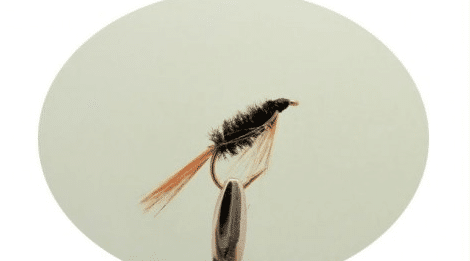
Buzzers
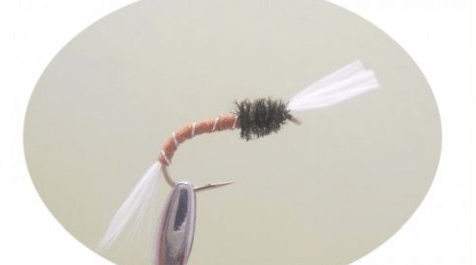
Bloodworm
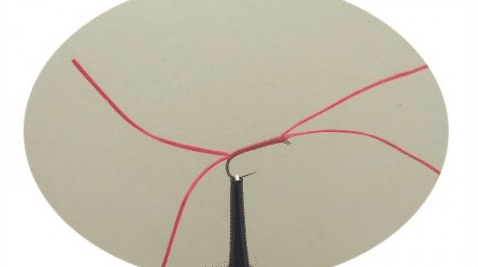
How to Fight Carp on the Fly
If you’re lucky enough to hook into a carp on a fly rod then you could be in for an absolutely wild fight. When you see a fish suck your fly into it’s mouth give the fish a split-second the fully get the fly in its mouth and then lift your rod without too much force to set the hook.
Setting the hook can go either way, some fish with bolt for deeper water as soon as they feel the hook or they may just sit still like a brick. No matter what happens though a gentle lift is all you’ll need to set the hook and avoiding breaking your leader.
As carp are generally larger, heavier and sometimes more powerful than your average trout you are going to want to manage the fight slightly differently on a fly rod.
It is recommended to manage the fight with your reel, if you have a reel with a decent drag system, rather than with your hands like a lot of trout anglers will do.
Once you set the hook on the fish keep a hold of the line and quickly reel in any excess line. This will give you far more control of the fish and if your drag is set correctly you will have far less risk of losing the fish or snapping off.
Like fighting all other types on a fly rod, keep the rod tip high and plenty of pressure on the fish to make sure the hook stays fixed in the fishes mouth.
Keeping the rod high will also keep plenty of pressure on the fish to stop it reaching snags or features which it could get tangled in resulting in a broken leader and a lost fish.
Once you manage to get the fish to your feet make sure your net is wet to avoid damaging the protective film that carp have.
There is also a knack to holding carp that you can find out all about in this post on how to hold carp.
How to Read Carp on the Surface
Unfortunately all carp you spot are not catchable. When stalking and fly-fishing for carp on the surface you need to be able to read the fish to know exactly what fish you should be casting your fly at for the best chance of success.
Carp Splashing
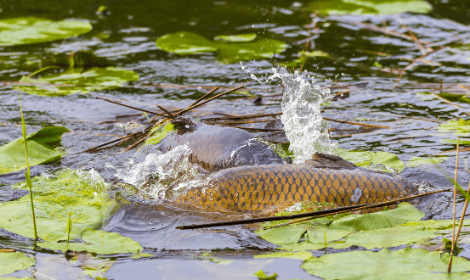
If you turn up to the water and the carp are extremely active and splashing about in the shallows you may as well jump back in the car and head home.
This act indicates that the fish are going throwing a spawning phase where they will do nothing else other than reproduce. If you happen to turn up during spawning season all hope is not lost.
Shortly after the fish have finished spawning they are going to be extremely hungry to replenish their energy after a few days of spawning with little to no eating.
If you can coincide you can return a day or two after spawning you could be in for some great sport catching carp on the fly.
Fast Moving Groups
Fast moving groups or singular fish are also not a great target at all. Carp are far from multi taskers and when they’re set on going somewhere it is very unlikely to tempt them with some bait or a fly on the surface.
When carp are moving linearly at fast speeds they are more than likely actively fleeing something, whether it be shadows on the water, something splashing in the water or a bait moving unnaturally, the carp are looking to leave the area very quickly.
Another reason the carp might be moving fast is that they are on a mission to get somewhere, for what? Most of the time we won’t know.
You might have a small chance of catching these fast moving fish but to be honest it’s probably not worth the hassle trying to get a fly in front of them at the perfect time and depth.
Slow Moving Groups
Now slow moving groups or fish that are moving in a non-linear way are great targets. This behaviour indicates that they are actively looking for food.
If you see fish acting like this, throw some free baits over the top of them, wait until they start feeding comfortably and then cast your fly delicately among the free baits.
Heads Down and Tails Up
Carp that have their heads down and tails up in shallow water are catchable but it’s unlikely you’ll catch them off the surface.
These fish are rooting through the sediment at the bottom of the water looking for food that is buried. You will be able to catch these fish on the fly but it’ll take a completely different approach than surface fishing.
That’s All!
Fly fishing for carp can be a real change from the more conventional methods. The hard fighting nature and size of carp make for a wild fight on fly rod and the extra challenge can be a make it a proper buzz.
I hope you’ve managed to a thing or two about catching carp on the fly in this post. If you have anything to add or any questions then feel free to leave a comment below.



